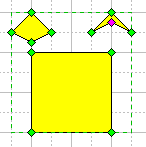
ConceptDraw offers you advanced features for working with objects of different types.
You can draw segments and figures, group objects into more complex ones, and connect them
with intelligent connectors.
The advanced drawing facilities help you draw and position the objects precisely, and glue
the objects to maintain the connections. In this way you can create precise and accurate
drawings quickly and easily.
ConceptDraw also lets you insert pictures from various graphic files.
What Objects You Can Use
Drawing Figures
Additional Operations on Figures
Facilities for Precision in Drawing
Pictures
Grouping Objects
To make your documents clear, varied and attractive, ConceptDraw offers you advanced drawing features. There are several kinds of objects which you can use in your documents. They will give you flexibility in creating the structures and connections in your drawings in the way it suits you best.
ConceptDraw lets you use the following types of objects:
Figures
Connectors,
Groups,
Pictures,
OLE objects (in Windows).
Figures
Figures can be made of different elementary segments. There are four
types of segments:
LineTo, SectorTo, ArcTo, SplineTo.

Connected segments form a solid path called Geometry. If the beginning of the first segment coincides with the end of the last one, the geometry becomes closed and is filled by default.


A figure may contain several geometries, so it may look like a group of several objects. But unlike the objects within a group, all geometries that form a figure always have the same line and fill properties. (A group may include any objects of different types with different line styles, fill colors, etc.).
See the "Drawing Figures" section for more information.
ConceptDraw also lets you work with special objects, such as connectors, pictures, and OLE objects. Connectors can be created by means of the application; pictures and OLE objects are imported from other applications or files.
Connectors
Connectors are used to connect two objects together. The connector's distinguishing feature is that it keeps the objects connected even if they are repositioned, resized, etc.

There are two methods for connecting: to the entire object
and to a connection point of an object.
See "Connectors" for more detailed
information.
Groups
A Group is composed of two or more objects. You can work with a group
the same way you work with a single object. For advanced editing options, you can open the
Edit Group (Figure / Edit Group). For simpler editing - modifying the
text of an object, line and fill properties - you can just select the object within
a group. If necessary, you can ungroup the unit to get separate objects.
See "Grouping Objects" for details.
Pictures
Pictures can be imported to ConceptDraw from graphic files of different formats:
BMP - Windows bitmap;
JPG - JPEG file;
GIF - GIF file;
WMF - Windows Metafile (in Windows system);
EMF - Enhanced Metafile;
PCT - Macintosh PICT file (in Mac system).
In ConceptDraw Professional, you can also import graphics from
DXF - AutoCAD DXF documents,
TIF - TIFF files,
PNG - PNG files,
TGA - TARGA files.
For the pictures, only limited editing is possible (rotating, resizing, etc.). See the "Pictures" section for more information.
OLE Objects
The Windows version of ConceptDraw supports Object Linking and
Embedding capabilities (i.e. it is an OLE-compatible
application). So objects created in other programs can be inserted into your document. In
ConceptDraw, OLE-objects can be repositioned and resized. For full editing, you will need
the application in which the object was created.
You can find more information in the section for "Working with
Other OLE-Compatible Applications".
See further:
Drawing Figures
Additional Operations on Figures
Facilities for Precision in Drawing
Pictures
Grouping Objects